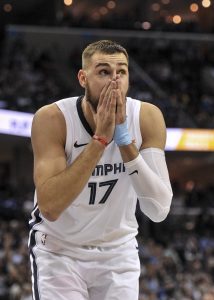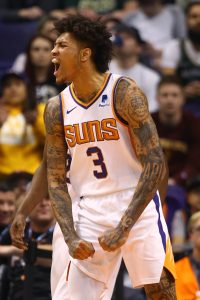With the 2018/19 NBA regular season now in the books, the draft lottery order has been set — mostly. A series of ties in this year’s reverse standings will create a little drama on Friday, when the league conducts random drawings to determine which of those tied teams will be slotted ahead of the other(s).
As our reverse standings show, this is what the lottery order looks like heading into Friday:
| Rank | Team | Record | No. 1 pick | Top-4 pick |
|---|---|---|---|---|
| 1 | Knicks | 17-65 | 14.0% | 52.1% |
| 2(t) | Suns | 19-63 | 14.0% | 52.1% |
| 2(t) | Cavaliers | 19-63 | 14.0% | 52.1% |
| 4 | Bulls | 22-60 | 12.5% | 48.1% |
| 5 | Hawks | 29-53 | 10.5% | 42.1% |
| 6 | Wizards | 32-50 | 9.0% | 37.2% |
| 7(t) | Pelicans | 33-49 | 6.0% | 26.3% |
| 7(t) | Grizzlies | 33-49 | 6.0% | 26.3% |
| 7(t) | Mavericks | 33-49 | 6.0% | 26.3% |
| 10 | Timberwolves | 36-46 | 3.0% | 13.9% |
| 11 | Lakers | 37-45 | 2.0% | 9.4% |
| 12(t) | Kings | 39-43 | 1.0% | 4.8% |
| 12(t) | Heat | 39-43 | 1.0% | 4.8% |
| 12(t) | Hornets | 39-43 | 1.0% | 4.8% |
Friday’s tiebreakers won’t have a real impact on this year’s lottery odds, since the teams that finished the season with identical records receive identical odds – or as close as possible – for a top-four pick. Still, those tiebreakers will be significant.
Whichever team wins the Suns/Cavaliers tiebreaker will be guaranteed a draft pick no lower than No. 6. The loser of the tiebreaker could slip all the way to No. 7 if teams leapfrog them on lottery night.
Meanwhile, the Grizzlies will actually be rooting against themselves in the seventh-place tiebreaker, since they want their top-eight protected first-round pick to convey to the Celtics this year. That way, they won’t have to worry about that commitment in future seasons as they consider a larger-scale rebuild.
Losing the three-way tiebreaker and ending up ninth in the lottery order would be ideal for the Grizzlies — in that scenario, they would either jump into the top four or would be assured of sending their pick to Boston. If they win the three-way tiebreaker, the Grizzlies would have better than 50/50 odds of landing at No. 7 or No. 8, a worst-case outcome.
As for the Mavericks, their pick would head to the Hawks if it’s not in the top five, so they currently have a 26.3% chance at retaining that selection. Atlanta will be rooting for Dallas to win that tiebreaker, which would substantially increase the odds of the pick ending up as high as No. 7.
The three teams at the very bottom of the standings have long odds to move up into the top four, but that tiebreaker will still be important since it will likely represent the difference between picking as high as No. 12 or as low as No. 14. Luke Kennard, Donovan Mitchell, Bam Adebayo, Miles Bridges, Jerome Robinson, and Michael Porter Jr. have been selected in that 12-14 range over the last two years.
Of course, the Celtics will receive that Kings first-rounder (unless it jumps to No. 1, in which the Sixers get it). So they’ll be keeping a close eye on Sacramento’s tiebreaker results.
Random drawings will also be conducted on Friday for several other tied teams further down the reverse standings — or further up the actual standings, if you prefer. Currently, nine of the final 16 first-round picks remain up in the air and will need to be determined via tiebreakers.
Here’s the rest of the tentative first-round draft order:
| Rank | Team | Record | Pick notes |
|---|---|---|---|
| 15 | Pistons | 41-41 | – |
| 16(t) | Magic | 42-40 | – |
| 16(t) | Nets | 42-40 | – |
| 18(t) | Spurs | 48-34 | – |
| 18(t) | Clippers | 48-34 | Traded to Celtics |
| 18(t) | Pacers | 48-34 | – |
| 21(t) | Thunder | 49-33 | – |
| 21(t) | Celtics | 49-33 | – |
| 23 | Jazz | 50-32 | – |
| 24 | Sixers | 51-31 | – |
| 25(t) | Trail Blazers |
53-29 | – |
| 25(t) | Rockets | 53-29 | Traded to Cavaliers |
| 27 | Nuggets | 54-28 | Traded to Nets |
| 28 | Warriors | 57-25 | – |
| 29 | Raptors | 58-24 | Traded to Spurs |
| 30 | Bucks | 60-22 | – |
Information from LotteryBucket.com was used in the creation of this post.
 Jonas Valanciunas
Jonas Valanciunas